Montessori Pathways' News
January 2011
Notes from Miss Alena
We’ve survived the Snowpocalypse Blizzard of 2011! Hopefully groundhog Phil was right and spring is just around the corner.
With warm thoughts in mind, I would like to welcome four new students to our school: Treyson, Danica, Mahi and Nikki . It’s a pleasure to have you join the Montessori Pathways family.
Ahead on the road is a Montessori Evening:
Language and Speech Development presented by Ms. Jocelyn this coming Thursday, February 10, at 7:00 p.m.
At this time of year, the parents of five year olds are faced with a common dilemma: where to send my child for Kindergarten? A common question for many of our parents is whether to continue with the Montessori school or transfer to another institution. I would like to remind everyone that this is the most important decision you will make regarding your child’s education (yes, even more important than choosing a college).
“There are many who hold, as I do, that the most important part of life is not the age of university studies, but the first one, the period from birth to the age of six. For that is the time when a man's intelligence itself, his greatest implement, is being formed. But not only his intelligence; the full totality of his psychic powers"
Maria Montessori The Absorbent Mind.
The question to ask yourself is whether it makes sense to halt the educational path your child is currently on, when he is finally at the peak of absorbing information and life skills like never before. After years of preparing the mind and learning the basics, the soon to be kindergartener is ready to take lead, to advance his education and leap ahead beyond his peer’s level. Transferring him to another environment now not only breaks off this chance but jeopardizes previously learned knowledge as it will not be reiterated nor strengthened in a kindergarten geared towards the majority—those who have yet to learn their colors.
Below I provide an adapted article about the kindergarten choice you face, along with pictures of our current Kindergarten Club. I trust this will answer many of the questions you have regarding this matter. While quite lengthy, I encourage you to find ten or so minutes in your hectic schedules to read through it and by the end you will no doubt realize that your time was not wasted.
Even if your child is not yet five years old, I believe the information in this article is quite essential for any Montessori parent. Remember that the investment you make in your child’s education now will not only benefit you in the near future, but in the years of high school, college and future professions. All these are much closer than we expect.
Warmly,
Miss Alena
Why Montessori for the kindergarten year?

Every year at reenrollment time and in thousands of Montessori schools all over North America, parents of four-almost-five-year-olds are trying to decide whether or not they should keep their sons and daughters in Montessori for kindergarten or send them off to the local schools.
The advantages of using the local schools often seem obvious, while those of staying in Montessori are often not at all clear. When you can use the local schools for free, why would anyone want to invest thousands of dollars in another year's tuition?
It is a fair question and it deserves a careful answer. Obviously there is no one right answer for every child. Often the decision depends on where each family places its priorities and how closely one school or another fits in with the hopes and dreams for their children.
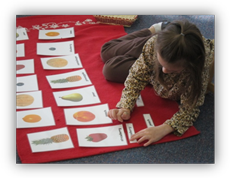
Naturally, the answer is often connected to the question of family income, although we are often amazed at how families with very modest means place a high enough priority on their children's education to scrape together the tuition needed to keep them in Montessori.
Thus, here are a few answers to some of the questions parents often ask about Montessori for the kindergarten age child.
In a nutshell, what would be the most important short-term disadvantage of sending my five-year-old to the local schools?
When a child transfers from Montessori to a new kindergarten, she spends the first few months adjusting to a new class, a new teacher, and a whole new system with different expectations. This, along with the fact that most kindergartens have a much lower set of expectations for five-year-olds than Montessori programs, severely cuts into the learning that could occur during this crucial year of their lives.
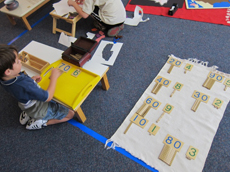 What Montessori kindergarteners do know, they know very well. Their understanding of the decimal system, place value, mathematical operations, and similar information is very sound. With reinforcement as they grow older, it becomes internalized and a permanent part of who they are.
What Montessori kindergarteners do know, they know very well. Their understanding of the decimal system, place value, mathematical operations, and similar information is very sound. With reinforcement as they grow older, it becomes internalized and a permanent part of who they are.
When they leave Montessori before they have had the time to internalize these early concrete experiences,
their early learning often evaporates because it is neither reinforced nor commonly understood.
What would be the most important advantages of keeping my five-year-old in Montessori?

Montessori approach to working with children is carefully based on what we've learned about children's cognitive, neurological and emotional development from several decades of research. Some of America's top experts on early childhood and elementary education have acclaimed the Montessori approach to be
the most developmentally appropriate model currently available.
One important difference between what Montessori offers the five-year-old and what is offered by many of today's kindergarten programs has to do with
how it helps the young child learn to learn.

Over recent years, educational research has increasingly shown that students in many schools don't really understand most of what they are being taught. Howard Gardner, Harvard Psychologist and author of the best selling book The Unschooled Mind goes so far as to suggest that
"Many schools have fallen into a pattern of giving kids exercises and drills that result in their getting answers on tests that look like understanding.

Most students, from as young as those in kindergarten to students in some of the finest colleges in America, do not understand what they've studied, in the most basic sense of the term.
They lack the capacity to take knowledge learned in one setting and apply it appropriately in a different setting. Study after study has found that, by and large, even the best students in the best schools can't do that."
(On Teaching For Understanding: A Conversation with Howard Gardner, by Ron Brandt, Educational Leadership Magazine, ASCD, 1994.)
Montessori is focused on teaching for understanding. In a primary classroom, three and four-year-olds receive the benefit of two years of sensorial preparation for academic

skills
by working with the concrete Montessori learning materials. This concrete sensorial experience
gradually allows the child to form a mental picture of
concepts like how big is a thousand, how many hundreds make up a thousand, and what is really going on when we borrow or carry numbers in mathematical operations.
The value of the sensorial experiences that the younger children have had in Montessori are often under-estimated by both parents and educators.
Research is very clear that young children learn by
observing and manipulating their environment, not through textbooks and workbook exercises.

The Montessori materials give the child concrete sensorial impression of abstract concepts, such as long division, that become
the foundation for a lifelong understanding.
Because Montessori teachers are well trained in child development, they know how to present information in developmentally appropriate ways.
In too many American schools, children do exercises and fill in workbook pages with little understanding.
There is a great deal of rote learning. Superficially, it may seem that these children are learning the material.
However, a few months down the road, little of what they "learned" will be retained. It is rare for these children to be able to use their knowledge and skills in new situations.
Learning to be organized and learning to be focused is as important as any academic work. Doing worksheets quickly can be impressive to parents, but there is hardly ever any deeper learning. Increasing educational research is beginning to focus on whether students, young or old, are really understanding or simply memorizing correct answers.
In a class with such a wide age range of children, won't my five-year-old spend the year taking care of younger kids instead of doing his or her own work?

The five year olds in Montessori classes often help the younger children with their work—teaching lessons or correcting errors.
Anyone who has ever had to teach a skill to someone else may recall that the very process of explaining a new concept or helping someone practice a new skill leads the teacher to learn as much, if not more, than the pupil.
Research has shown time and time again that
when one child tutors another, the tutor normally learns more from the experience than the person being tutored.
Experiences that facilitate development of independence and autonomy are often very limited in traditional schools.
Isn't it better for kids to go to school with the children from their neighborhood?

Once upon a time, people bought a home and raised their family in the same neighborhood for years on end. There was a real sense of community. Today, the average family will move two or three times before their children go off to college. Many public schools expect a turnover of more than 20% of their population a year as families move in and out of the area. The relationships that once bound families living in the same neighborhood together into a community have grown weak in many parts of the country.

In Montessori schools, however, families who live in different neighborhoods but who share similar values have come together to create and enjoy the extended community of their school.
Children growing up in Montessori schools over the last fifty years often speak of how closely knit their friendships were with their schoolmates and families.
Since most children will eventually have to go to the neighborhood schools, wouldn't it be better for them to make the transition in kindergarten rather than in first grade?

The American Montessori Society tells of one father who wrote,
"We considered the school years ahead. We realized a child usually does his best if he has good learning habits, a sound basis in numbers and math, and the ability to read. We realized that he has had an excellent two-year start in his Montessori school. If he were to transfer now to kindergarten, he would probably go no farther than he is now, whereas if he stays in Montessori, he will reap the benefits of his past work under the enthusiastic guidance of teachers who will share his joy in learning."
Many families are aware that by the end of the kindergarten year,
Montessori students will often have developed academic skills that may be beyond those of children enrolled in most American kindergarten programs.
However, parents should remember that academic progress is not our ultimate goal. Our real hope is that the children will have an incredible sense of self-confidence, enthusiasm for learning, and will feel closely bonded to
their teachers and classmates.
We want much more than competency in the basic skills; we want to them to honestly enjoy school and feel good about themselves as students.

Once children have developed a high degree of self-confidence, independence, and enthusiasm for the learning process, they can adapt to any new situations. While there are many reasons to carefully consider keeping a child in Montessori through elementary school and beyond, by the time they are first graders, the kids will typically be ready to go off to their new school with vibrant curiosity and excitement about making new friends and learning new things.
If I keep my child in Montessori for kindergarten, won't he/she be bored in a traditional first grade program?
By the end of their fifth year, Montessori children are curious, self-confident, enthusiastic and engaged learners who look forward to going to school, want to learn and ask excellent questions.
What teacher wouldn't give her left arm for a room filled with children like that? Well, truthfully, over the years we've found some who consider these children "disruptive." “Disruptive?” you ask. A polite, independent, Montessori child, disruptive?
First off, let's remember that Montessori children are real human beings,

and not all children who attended Montessori fit the idealized description. However, enough do that the generalization is often fairly accurate.
By age six, Montessori children have spent three or four years in a school where they were treated with honesty and respect.
While there were clear expectations and ground rules, within that framework their opinions and questions were taken quite seriously. Unfortunately, there are still some
teachers and schools where children who ask questions are seen as challenging authority. You can imagine an independent Montessori child asking his new teacher,
But why do I have to ask each time I need to use the bathroom? or Why do I have to stop my work right now?
So the honest answer is that it depends on the teacher and school.

From an academic viewpoint, Montessori children will generally be doing very well by the end of kindergarten, although, once again, that is not our ultimate objective.
The program offers enriched lessons in math, reading, language, and a wide range of lessons in science, geography and other cultural areas. If they are ready, they will develop excellent skills and become quite "culturally literate."
When one of these children enters a traditional first grade, they may have already mastered the skills that their new school considers the first grade curriculum. Some Montessori children are still more advanced. Once upon a time in America, elementary schools had only one course of study for every child at each grade level, and the only option for children who were academically gifted was to skip ahead one or two grade levels. This created all sorts of resentments, jealousies among students, and social stresses on children who socially and physically still belonged with their own age group.
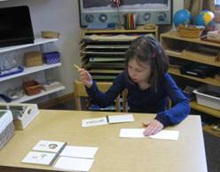
However, as Dr. Montessori's educational strategies have been incorporated to a greater or lesser extent by more and more school systems, it is becoming more common to find elementary schools that are willing and able to adapt their curriculum to meet the needs of individual students who are ready for accelerated work.
The key concept in Montessori is the child's interest and readiness for advanced work. If a child is not developmentally ready to go on, she is not left behind or made to feel like a failure. Our goal is not to ensure that our children develop at a predetermined rate, but to ensure that whatever they do, they do well. Most Montessori children master a tremendous amount of information and skills. Even in the rare case where one of our children may not have made as much progress as we would have wished, he will usually be moving along steadily at his own pace and will feel good about himself as a learner.
Written by Tim Seldin (President of the Montessori Foundation and Chair of the International Montessori Council) with Dr. Elizabeth Coe (Past President of the American Montessori Society and Director of the Houston Montessori Teacher Education Center in Houston, Texas.)
Miss Alena
Notes from the classroom:
Miss Jocelyn and Miss Christine
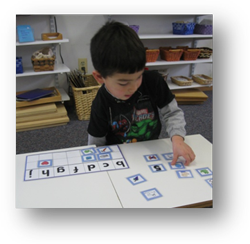
2011 is off to a great start! January is always a natural transitional time in Montessori classrooms where children often make the move to challenging themselves in new areas of work. This month was no different; as we guided each child with presentations of new works the thoughtful and focused concentration was widespread. It is always exciting to witness the excitement of a child who has learned something new through exploration and discovery!
January also allowed us to welcome several new friends to our classroom community. Treyson, Nikki and Danica all started within one week of each other and the children have all taken turns helping,
guiding and showing our new friends the routine of the classroom. One of the beauties of a multi-age classroom is, it allows older children to act as role models and mentors to the younger children. It was wonderful to see some our youngest children take on this role with our new friends this month. We are thrilled to have three new children in our class!

This month many children began to explore the idea place value and exchanging quantities in math using a game called
Handful Exchange. The work is simple, yet an important step in a child’s understanding of quantities and place value in relation to addition and subtraction. Handful Exchange is played once a child has worked with the hands-on materials representing
ones, tens, hundreds and thousands.
Handful exchange begins with one child taking one handful of unit cubes (ones). Then she begins to count her units, stopping when she reaches 10. She then picks up the ten units and exchanges them with another child for one ten bar. This continues on until all ones are exchanged for ten bars as is possible. Finally, the child counts his ten bars and unit cubes to come up with his total. In a variation of this game, two children can also play using handfuls of ten bars and exchanging them for hundred squares. Handful exchange is a concrete representation of “carrying” in addition.
The mathematical concept that once we have 10 of something, we exchange it for the next higher value is the basis for advancing to more complex math work.
An ongoing
topic of discussion in the classroom this month was
Kindness: What it means to be kind, how to use kind words, how to respond if someone is being unkind, how to offer help to others and how to agree if someone asks you for help. Children between three and six are still learning how to navigate socially and emotional in a community. As we discussed these ideas, read books and worked on activities that focus on kindness we continue to model every day a strong and confident approach that empowers each child to be kind and not accept unkindness from others. One of the children’s favorite books we read on this topic was
One, by Kathryn Otoshi. This is a beautiful book that focuses on using kind words, standing up for yourself, helping friends and being inclusive of everyone in a very unique and clever way.
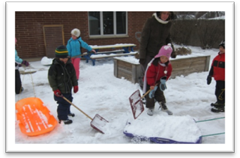
We’ve been lucky to enjoy the winter on our playground sledding and shoveling – this past snowfall has brought colder temperatures but the children are excited to get back outdoors to play in all the snow. Please remember to make sure they have all the proper winter gear such as waterproof mittens, snow pants, boots, etc. because we do try to go out each and every day it’s 20 degrees or above……..
Inside our classroom, we’ve enjoyed making muffins and experimenting with different and diverse food preparation activities. Please remember to include these activities with your children at home; they are very energetic and adept at
setting lunch tables and cleaning up before and after lunch. Counting the number of friends staying for lunch and having snacks as well as preparing the food is a challenging and fun activity. Ironing the lunch napkins, setting the tables, pouring milk and water, and serving themselves helps in their quest for self care and ultimately self control and confidence.

In the practical life area, we’ve been honing our fine motor skills with spooning liquids, stringing beads, sorting and pouring activities, opening/closing different containers and sewing. Sweeping, scrubbing and squeging the mirrors and windows of the classroom favorites of many.
Some of the art activities introduced this month were using dot paint markers to create pictures,
chalk, craypas, and mixing paint to create new shades of a favorite color for painting.
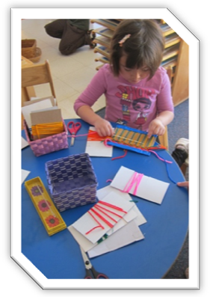
Thank you to all our families for your generous donations to the Sharing Basket. We have enjoyed sharing your contributions together.
Looking ahead to February: Are you interested in learning how we teach letter sounds and reading in the classroom? Be sure to sign up for our parent meeting on Language Development this month. If you haven’t yet made it to one of the parent nights this year, I highly recommend coming to this one. Language Development is really the one area of the classroom that ties everything together in a way that makes Montessori so unique and wonderful.
In February, we will use some of the upcoming holidays to introduce new activities for the children in the classroom. Starting with Groundhog’s Day, we will begin to explore the idea of shadows with some fun science and art activities. Chinese New Year begins February 3rd and so begins our exploration through stories about a holiday that most of us do not celebrate, but millions around the world do! For President’s Day, we will introduce hands-on money activities including penny polishing, piggy bank coin counting and coin rubbings as an introduction to George Washington.
Finally, for Valentine’s Day we would like to invite each child to bring in a valentine collection box or bag that he or she decorated and created at home along with his or her valentines. The children love to pass out Valentines and homemade boxes are fun for each child to share the story about how the container was made.
Miss Jocelyn and Miss Christine
Notes from the classroom:
Miss Karen and Miss Ambreen
The Gifts of Montessori (Continued from last month)
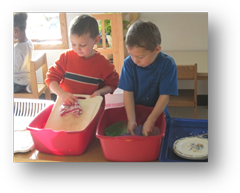
Some of the gifts we talked about were independence, making choices, self-direction and growing independence and competence of the child. It follows that if these are key goals for the children in the Montessori classroom, activities must be made accessible and available.
Everything has a procedure so that the adults can be consistent in showing the children how to do an activity. Furthermore, the procedure has been thought-out and tried several times so that we know the child will succeed if they follow the steps. It will help the children to think and plan ahead to assemble all they need to complete an activity.

At the art parent meeting for example, before the children get paint for use at the easel, they are shown how to get water for cleaning their brush, how to get water for cleaning the paint off the easel, how to put on the paint shirt, how to clip up their paper at the easel and to put their name on the paper. Then we check together to see that there is a paint brush, a sponge for clean-up, and a cloth for drying the wet easel. In this way, success and independence are assured. They have available everything they will need to take care of the cleanup BEFORE they begin to paint. Additionally, they have been shown the process of cleaning up previously. As much as possible, the cleanup for any activity is similar. In this way, they do not need to be shown every cleanup for every activity.
Painting is but one of a multitude of activities that are prepared in this way. Thus, over a period of time, the children learn more and more activities which they can select from and do independently without the assistance of the teacher. Over a period of time, they grow in capability, independence and contentment. Additionally, once a material is put into the classroom, it is left in that same place so the children can locate it when they need it. Aprons are always hanging on hooks at the end of the counter, paper towels are always in a basket on top of the supply shelf, the going home work box is near the door, etc. Literally hundreds of details comprise the organization of the Montessori classroom.
Many times visitors are amazed at the accomplishments and the independence of the children. Questions include: "Who told that little boy to wash his hands?" (Before snack or food preparation, the children always wash their hands.) How did the child know how to clean up the art easel"? "Who helped them prepare their snack?"
Off the Shelf
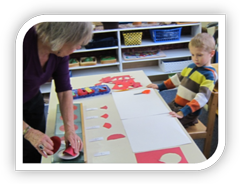
This material consists of two boards (trays) with 10 “fraction circles”. These are actually metal insets in the shape of a circle. They are divided in parts beginning with one whole, undivided circle to a circle divided into 2 parts, 3 parts, 4 parts, etc to 10 parts. This material can be worked at a simple level as a puzzle.
But, at a more complex level, with this beautiful material, we can concretely illustrate the function of a denominator (how many parts is the circle divided into?) and the function of the numerator (how many of those parts are we going to work with?).
After initial lessons involving the above concepts, children easily and UNDERSTANDABLY do functions involving fractions. We begin with simple addition using the same denominator --- how much are 2 sixths and 2 sixths. Since we can actually remove 2/6 and 2/6 from the circle that was divided into sixths, it becomes a simple addition problem, much like 2 apples and 2 apples.

We can work through all the functions of arithmetic (addition, multiplication, division and subtraction) using the fraction boards. Eventually, the children also can make equivalencies because the material functions much like a puzzle with missing pieces. For example, how many ways can we make one half? The child can manipulate the pieces and see that the following fit into the space of one half of the circle: 2/4, 3/6, 4/8, 5/10. We see that there is a RELATIONSHIP: all of the denominators are even numbers. The children can then predict the continuing sequence: i.e. 6/12, 7/14, etc.
VISUALLY, children can see that the more pieces an object is divided into, the smaller each piece, the less we have. (Counter the usual math that the larger the number, the more we have.).
It is a wonderful example of a classic Montessori material that can be used in multiple rich ways and leads to an understanding of mathematical principles.
“These words reveal the child’s needs: Help me do it alone.”
Maria Montessori
Miss Karen and Miss Ambreen
Kindergarten Extended Day
Curriculum

Isn't time an amazing thing? Looking back, it has only been a few weeks, yet so much has taken place! We began the month with sink and float demonstrations. We enjoyed trying to predict the outcome of each object. The coolest part was that something could sink (a ball of clay) and then, by simply changing its shape, it could be made to float. One of the children expressed their theory: "you didn't add anything or take anything away, so, of course, it will sink". Hence the surprise outcome.
We celebrated Martin Luther King Day with a story about segregation and its impact on the lives of people. For me personally, I love the day as a reminder of the history I clearly remember.
We presented the composition of the Earth: inner core, outer core, mantle, crust. As the story was told, a model of the ideas was being constructed out of clay. The climax came in cutting the sphere in half to reveal the cross section of the earth's composition. The children were so excited they applauded at the revelation. And they loved making their own models.
Mathematical Thinking

Okay. It was story time again. We acted out the idea that there was a time before numbers existed. A time before counting existed. True. Math had to be invented by mankind. So how did the shepherds' keep track of their sheep? How did they know when one became lost? Well the children LOVED being sheep with one of the flock lost. We knew we had to find the missing sheep. But how could we keep track? Well, with a basket of stones, one for each sheep or with a rope with knots, one for each sheep or with notches on a stick, one for each sheep. It was actually a cool way to act out the idea of one to one correspondence, the foundational rule for counting. The bonus was everyone got to baaaa like sheep!
Another math game we played: how many pennies did I take away? Implied subtraction --- a fun way to think and analyze.
Language Development
Through stories and lessons with objects, we began to introduce the "parts of speech". We begin with the articles "a" and "the" which are the indefinite and the definite articles. Through use of objects and various directions, we can communicate the appropriate use of the article. This will be followed by study of the adjective.
We have also begun the study of simple poems. With a close look at some selected poems, we can include study of punctuation marks as symbols that help to make the meaning of a passage clear. It is also an opportunity for word study, including sound-alike words, repetition, and word play that make poems enjoyable to read aloud.
Field Trips
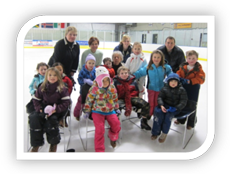
Our field trip to the ice rink was a resounding success. Thank you, in particular to Jennifer Altman, Christine Martinez, and Amanda and Robert McGuire for helping our new skaters around the ice. What made it so successful was the use of chairs to hold up the children when they were skating. That, of course, led to children giving each other (and the teachers) rides on the chairs. Their energy was inexhaustible and a good time was had by all.
Artist of the Month
We have had a delightful time looking at Monet. With Miss Terri, the children looked at kinds of brush strokes (follow-up to the winter tree project) and use of thickened paint to get different effects. (See Miss Terri for additional details). Our art program does not focus on "making our children into artists". We are all artists already. We want to provide skill in techniques and provide inspiration. Then their creative energy can flow.
The artist we will be highlighting this month is Marc Chagall. The technique will be mosaic expression. We are fortunate to have Chagall's works in Chicago. The artist has a strong connection with our city. Seeing his work in person could be a wonderful family "field trip". His beautiful work, America Windows, is located in the Art Institute. This was a gift to the city of Chicago and is dedicated to Richard J. Daily. Chagall's 70 foot mosaic, The Four Seasons, is located in the Chase Tower Plaza, the geographic center of The Loop
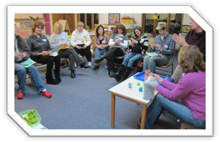
We too were artists this month. Thank you to all the parents who came to the sensory motor/art parent night. We had a great time and know that you did too. It was especially fun for the adults to become children and, under Miss Terri's guidance, become artists for the remainder of the evening. We experienced such enjoyment and engagement, just as your children do. Wish we could do that all the time. It was inspiring to us too.
Miss Karen
Notes from the classroom:
Miss Terri and Miss Donna
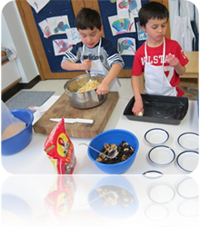
January was a very busy month in the afternoon class. We started off reading a lovely story called “Marshmallow”. The story is about a cat named Oliver who lived in an apartment and had never even seen another animal. Marshmallow, the rabbit arrives and they are both afraid of each other. The bunny however pursues the cat for he is also warm and fuzzy and reminds him of his family. It's a wonderful story about overcoming fear for friendship.
For an art project, we made clay rabbits using modeling clay in the basic shapes of ball, cylinder and flattened coils. For a second art project we drew the rabbit, Marshmallow. We practiced our shapes, outlined them with markers, and then colored our pictures.
For snack that week we had, of course, rice crispie treats with marshmallows, prepared with kids (great team work).

During the second week in January we introduced our artist of the month, Claude Monet. I demonstrated the painting technique of wet on wet. First you wet the paper with the brush and water and then use watered down tempura and the sides of the brush for the smooth water and sky effect. The children used a limited pallet of blue, yellow and white. We made beautiful turquoise and lime green for the water and sky. We then mixed colors for the grasses, trees, and lily pads. We added the bridge last when the painting was dry. We again practiced using the side of the brush for smooth areas and the tip of the brush for details and textures.
One last Monet study was to look at a close up of Monet's huge wall paintings of water lilies. The flowers looked like splotches and blobs close up with lots of thick brush strokes showing. We thickened the tempura paint with corn starch and mixed our colors to paint close up lilies on 6" x 6" squares of poster board. The children also practiced different techniques with sponge brushes. They found if they twirled the square sponge it made a circle of paint on their paper.
We made another clay animal this month after we read Eric Carl's "Seahorse". We mixed all kinds of colors of modeling clay. First we warmed the clay in our hands to make it soft. Then we made our own rainbow colored seahorses to take home.
Speaking of clay....before I forget, here is the play dough recipe I promised at the art workshop night. We (parents and teachers) had fun experimenting with three different kinds of clay; play dough, modeling clay, and pottery clay. Each had a different texture and feel and the parents were able to have some fun and make pinch pots, coils, and even a bunny and a turtle.
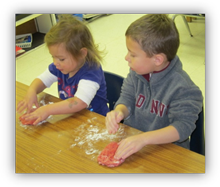
Play dough recipe: 2 cups of flour, 1 cup of salt, 2 tablespoons of oil, 2 cups of water, 2 teaspoons of alum, food coloring of choice. Boil water with oil. Add food coloring and alum. Remove from stove. Mix dry ingredients, add to hot mixture, roll out onto floured mixture and knead until mixed. Store in zip lock baggie - keeps for a long time. Have fun!
For P.M. snacks this month, the children really enjoyed the clementines the parents sent in. The snack helpers peeled and separated the sections and then counted 5 pieces into each of the 25 snack dishes. Quite a lot of work for those small fingers.
We also made ants on a log with celery, cream cheese and raisins. We sliced lots of fruit for the dehydrated - bananas, pineapples and apples. Parents - feel free to send in any extra fruit you find on sale at the store. It is always welcome and rapidly consumed. We again made carrot cake - another favorite - with three cups of shredded carrots. Another favorite snack for the children is our crunchy trail mix. We use any and all crackers, cereals, pretzels, and add raisins, craisens, and tiny marshmallows. Mix and serve. It's fun and each serving is different.
We took advantage of the snow and learned that salt makes snow melt faster, food coloring can be used on snow to make designs and is great for mixing colors and it was fun squirting water out of a baster into the snow.
We also enjoyed making our own snowflakes out of paper. We made mystery pictures by using old candles to draw a picture on white paper. This was hard because we could not see what we were drawing. When we added a blue wash over the paper our drawing began to appear.
January had us working on increasing our endurance. We were able to run, jump, gallop and skip for a minute or more. February we will be trying for 2 minutes.
We learned two games this month. The first was Silent ball: we learned how to throw a ball to another person so that they would be able to catch it without anyone talking or laughing. The talking and laughing were the hard parts. The second game was called Over, Under and Over then Under. After dividing into teams they passed a ball over their heads when the ball reached the last person, the last person would come to the beginning of the line and begin again. Then we tried going through our legs and ended up with the first person going over, the second person going through etc. The hard part was remember if they should go over their head or through their legs.
Miss Terri and Miss Donna
Dance News
After a beautiful winter performance of the “snowflakes,” we are all ready to move on to our spring dance! We have been working on our acting skills as we dance and experiment with different styles of music to see how they make us feel and how the music changes our dance movements and facial expressions.
Dancing with scarves really has helped the girls use their arms and upper bodies to express themselves. Creative movement has been explored through moving like arctic animals and learning a fun penguin dance.
We are discussing the ballet, Swan Lake, and are learning different dances from the ballet. The dancers will be performing “the little swans” dance in May. They will need a pink leotard, pink tights and pink ballet shoes.
Please make sure your daughter has leather or canvas ballet shoes, not slippers. The slippers are extremely hard to dance in.
Miss Brittany
